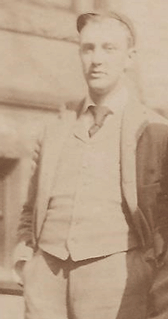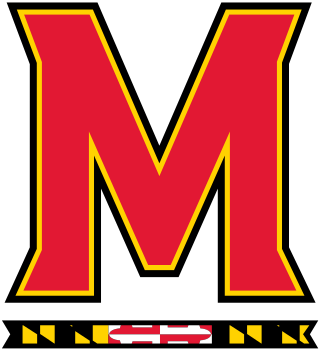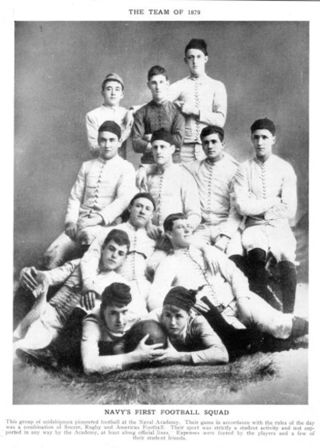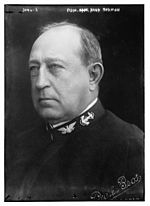
Robert Means Thompson Stadium was an American football stadium in the eastern United States, located on the campus of the United States Naval Academy in Annapolis, Maryland. Constructed in 1914, it was the home stadium of the Navy Midshipmen from 1924 through 1958, and was named after alumnus Robert Means Thompson (1849–1930). He created or led several athletically-based organizations at the academy until his death. It was succeeded by the larger Navy–Marine Corps Memorial Stadium in 1959, the current venue of Navy football.

The Navy Midshipmen football team represents the United States Naval Academy in NCAA Division I FBS college football. The Naval Academy completed its final season as an FBS independent school in 2014, and became a single-sport member of the American Athletic Conference beginning in the 2015 season. The team is currently coached by Brian Newberry, who was promoted in 2022, following his stint as the Midshipmen defensive coordinator. Navy has 19 players and three coaches in the College Football Hall of Fame and won the college football national championship in 1926 according to the Boand and Houlgate poll systems. The 1910 team also was undefeated and unscored upon. The mascot is Bill the Goat. Attendance of home football games is required for all students. Members of the Billy the Kid Club can attend home football games for free.

The Navy Midshipmen are the athletic teams that represent the United States Naval Academy. The academy sponsors 36 varsity sports teams and 12 club sport teams. Both men's and women's teams are called Navy Midshipmen or Mids. They participate in the NCAA's Division I, as a non-football member of the Patriot League, a football-only member of the American Athletic Conference in the Football Bowl Subdivision (FBS), and a member of the Collegiate Sprint Football League (men), Eastern Association of Rowing Colleges (men), Eastern Association of Women's Rowing Colleges, Eastern Intercollegiate Gymnastics League (men), Mid-Atlantic Squash Conference (men) and Eastern Intercollegiate Wrestling Association. Navy is also one of approximately 300 members of the Eastern College Athletic Conference (ECAC).

Benjamin Lewis Crosby Jr. was an American college football player and coach. Born in Halcott Centre, New York, Crosby attended Yale University beginning in 1889; while there, he was a popular student and sportsman. He was a two-year starter on the football team and a backup on the crew team. During his junior year, he was replaced on the football team by freshman Frank Hinkey and never returned to a starting position. The remainder of Crosby's time at Yale was successful and he enrolled at the New York Law School after graduation.

The 1924 Rose Bowl was a postseason American college football bowl game played between the independent Navy Midshipmen and the Washington Huskies, a member of the Pacific Coast Conference (PCC). The game took place on January 1, 1924, at the Rose Bowl stadium in Pasadena, California, closing the 1923 college football season. The game opened in front of approximately 40,000 people and ended in a 14–14 tie. It was the first post-season bowl game for both teams. The 1924 game was the tenth edition of the Rose Bowl, which had first been played in 1902. Following the inaugural game's blowout score, football was replaced with chariot races until 1916. The Rose Bowl stadium had been constructed in 1923, making this edition the second game played in the arena.

The Crab Bowl Classic is the name given to the Maryland–Navy football rivalry. It is an American college football rivalry between the Maryland Terrapins football team of the University of Maryland and the Navy Midshipmen football team of the United States Naval Academy. The two institutions, located in close proximity in the state of Maryland, first met for a football game in 1905. Since then, the series has often been marked by controversy, with incidents by players and supporters occurring both on and off the field. The winner of the game is awarded the Crab Bowl trophy.

Vaulx Carter was an American naval officer, athlete, and engineer associated with the United States Naval Academy football program. Carter was born in Tennessee, a member of the Carter family of Davidson County, and included among his siblings Medal of Honor recipient William Harding Carter and New Age religious figure Laura Carter Holloway. Raised in Brooklyn following the deaths of his parents, Carter was admitted into the Naval Academy at the age of 17. While there, he revived the school's football program and led it as player and coach, later earning the epithet "father of Navy football". An accident in 1883 left Carter permanently disabled and forced him to resign from the Naval Academy.

The Johns Hopkins Blue Jays football team represents Johns Hopkins University in the sport of American football. The Blue Jays compete in Division III of the National Collegiate Athletic Association (NCAA) as members of the Centennial Conference. Johns Hopkins has fielded a team since 1882. Johns Hopkins has won or shared 13 Centennial Conference titles since the 2002 season, including 10 straight titles through the 2018 season.

The 1882 Navy Midshipmen football team represented the United States Naval Academy in the 1882 college football season. The team was the second intercollegiate football squad to represent the United States Naval Academy, and the first since 1879. The team was coached by player-coach Vaulx Carter, and was entirely student-operated. It was captained by squad member Alex Jackson. The team played just a single game, an 8 to 0 (8–0) shutout of Johns Hopkins, which was the school's first ever win. The squad was entirely student operated, and was not supported by the Naval Academy's faculty. The season would mark the beginning of eight season rivalry between the Midshipmen and Johns Hopkins.
The 1883 Navy Midshipmen football team represented the United States Naval Academy in the 1883 college football season. The team was the third intercollegiate football squad to represent the United States Naval Academy, and the first time the school participated in consecutive seasons. The squad was captained by member Frank Hill. The team played just a single game, a 2 to 0 (2–0) shutout loss to Johns Hopkins, which was the school's first ever loss. The squad was the first to have the approval of the academy's staff, and is regarded as the first official game played by the Midshipmen. The season continued a seven-season, eight game rivalry between the Naval Academy and Johns Hopkins.

Worden Field is a large grass field located on the campus of the United States Naval Academy in Annapolis, Maryland. First mentioned in 1890, the field served as the home stadium for the academy's Midshipmen football team from that year through 1923, replaced by Thompson Stadium in 1924. Since the early 1900s, the field has hosted all of the academy's various yearly parades and many of its drills. It has progressively grown smaller, due to the addition of buildings and roads within the academy.

The Johns Hopkins–Navy football rivalry was an American intercollegiate football rivalry between the Johns Hopkins Blue Jays football team of Johns Hopkins University and the Navy Midshipmen football team of the United States Naval Academy. The two institutions, located within the span of a few miles in the state of Maryland, first met for a football game in 1882. Following the initial contest, both teams played each other annually for eight years, before it was called off for unknown reasons. The teams competed again in 1911 and 1912, again disbanding the contest until a final match took place in 1919.
The 1884 Navy Midshipmen football team represented the United States Naval Academy in the 1884 college football season. The team was the fourth intercollegiate football squad to represent the United States Naval Academy, and was the final time the school played a single-game season. The squad was captained by rusher Jim Kittrell. The team's single game was a 9 to 6 (9–6) defeat of rival-school Johns Hopkins. The season continued a seven-season, eight game rivalry between the Naval Academy and Johns Hopkins. It was the final season that a Naval Academy team would go unbeaten and untied.
The 1885 Navy Midshipmen football team represented the United States Naval Academy in the 1885 college football season. The team was the fourth intercollegiate football squad to represent the United States Naval Academy, and marked the first time that the school played a multiple-game season. The squad was captained by halfback Cornelius Billings. The year began with a blowout victory over St. John's College, but was followed by close losses to Johns Hopkins University and the Princeton Tigers reserves squad. The season continued a seven-season, eight game rivalry between the Naval Academy and Johns Hopkins, and began a ten-game, seven-year rivalry with St. John's.
The 1886 Navy Midshipmen football team represented the United States Naval Academy in the 1886 college football season. The team marked the second time that the school played a multiple-game season. The squad was captained by halfback Clarence Stone. The year began with consecutive wins over rivals St. John's College and Johns Hopkins, but then regressed with a loss to the former and a close victory over the latter. The year concluded with shutout losses to the Princeton reserve squad and Gallaudet. The season was the program's longest until 1890, when that year's team played seven games.

Charles Cabaniss was a midshipman in the United States Navy and early player of American football. Born and raised in Central Virginia, he was appointed to the United States Naval Academy at the age of 16. At the academy, Cabaniss retained average-level grades and was a member of the school's first-ever football team. He graduated in 1880 and was appointed to the USS Swatara. Cabaniss was killed in an accident on the Swatara in 1882 which received coverage throughout much of the Eastern United States.
The 1887 Navy Midshipmen football team represented the United States Naval Academy during the 1887 college football season. The team compiled a 3–1 record and outscored its opponents 41 to 22. The Midshipmen shut out their first three opponents, including an 8–0 victory in the seventh installment of the Johns Hopkins–Navy football rivalry. The Johns Hopkins game was played at the Academy grounds in Annapolis, Maryland, and was described by The Sun as "a veritable slugging match" and "one of the roughest games of football" ever seen there. In the final game of the 1887 season, the Midshipmen lost to the Princeton Tigers "B" team in the final game of the season. The team captain was George Hayward.
The 1882 Clifton Athletic Club football team represented Johns Hopkins University in the sport of American football during the 1882 college football season. Hopkins' first team was assembled in 1881, and spent an entire year training and learning a version of the game. Their sport, which was closer to rugby, was played in Druid Hill Park. After the training, the team planned a two-game 1882 season. The squad had to play the season under the title of the Clifton Athletic Club, due to the school's policy on the sport of football. The first was a practice game with the Baltimore Athletic Club, played on October 7. The Hopkins team lost the contest 4–0. The following game was their first true game, to be played against the Naval Academy.

The 2017 Navy Midshipmen football team represented the United States Naval Academy in the 2017 NCAA Division I FBS football season. The Midshipmen were led by tenth-year head coach Ken Niumatalolo and played their home games at Navy–Marine Corps Memorial Stadium. The Midshipmen competed as a member of the West Division of the American Athletic Conference and were third-year members of the conference. They finished the season 7–6 overall and 4–4 in AAC play to tie for third place in the West Division. They were invited to the Military Bowl, where they defeated Virginia, 49–7.












